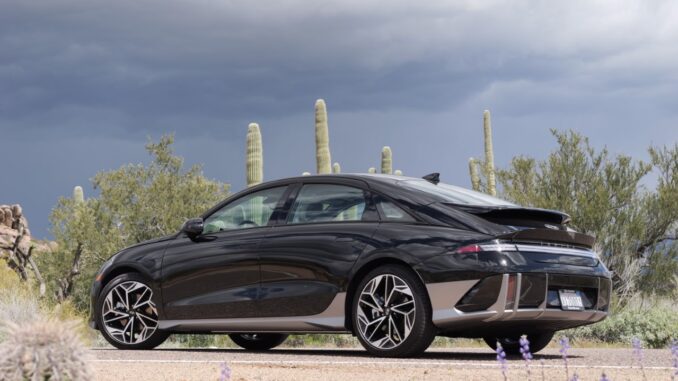
SCOTTSDALE, Ariz. — Hyundai has done something interesting with its electric car platform.
Whereas most electric cars are running on a 400-volt architecture, Hyundai chose to spend what were likely billions of extra dollars to develop a mainstream 800-volt architecture for its EVs called E-GMP. This not only added R&D costs but also made the vehicles more expensive to build — but there’s a big payoff in the end.
Even “new” EVs like the Cadillac Lyriq, built on GM’s latest and greatest Ultium platform, are running on 400-volt, as is the Ford F-150 Lightning and even Tesla’s Model 3 and Model Y. This isn’t necessarily a bad thing. The main difference, at least so far as the user is concerned, is in charge speed.
Without getting too deep into the physics, a car with an 800-volt battery pack can generally charge twice as fast as with a 400-volt pack. As a result, Hyundai’s Ioniq 5 and my test car this week, the Ioniq 6, can charge their batteries from 10 to 80 percent in just 18 minutes (at an appropriately equipped fast charging station), while a Ford Mustang Mach-E would take two to three times as long.
If you imagine the voltage as a garden hose, the 800-volt system is a larger hose and thus can carry significantly more water to the battery or the motor. Or think of it as a four-cylinder engine versus a V8. The net effect is that vehicles built on Hyundai and Kia’s E-GMP platform are significantly more future-proofed than much of the competition.
In three or four years, an Ioniq 6 bought today will still charge at up to 350 kWh — likely as quickly as the then-new vehicles from folks like Ford and GM — while a Ford Mustang Mach-E bought today will continue to max out at around 150 kWh. That ability to charge quickly is the number one reason to buy the Hyundai Ioniq 6.
A midsize sedan similar in size to the Hyundai Sonata, the Ioniq 6 nonetheless punches well above its weight and continues Hyundai’s climb into the ranks of premium vehicles alongside brands like Mazda. The bang for the buck in the Ioniq 6 is impressive.
Inside, you get a pair of large displays dominating the dash, with a comfortable and attractive steering wheel that is, curiously, missing any brand logo. Instead of the Hyundai H, you see a series of four lit-up dots in the center of the wheel — dot-dot-dot-dot being Morse code for the letter H. These glow blue during normal operation but go red when you’re in reverse as an extra telltale that you might not be going in the direction you expect.
Thankfully, there is a volume control knob, but there’s also a somewhat odd “touch” setup with fixed controls for adjusting the climate. Like the Ioniq 5, there are no permanent buttons for the heated seats, which is frustrating, but at least in the Ioniq 6 there is a permanent button that takes you to the screen where you can turn the seat heaters.
In other odd design decisions, the window controls are next to the center console, behind the dual cupholders, and exactly where a woman might put her handbag. There is ample room here for seat heater buttons, by the way, but moving the window switches there does make the doors sleek and streamlined.
There is a wireless phone charger and a USB-A charging port, and there’s a massive storage spot underneath this flying console, probably where the handbag should go. Thanks to the completely flat floor, the interior is incredibly spacious, and the car feels significantly larger inside than a midsized sedan. Rear seat legroom is impressive, and the apocryphal two-adult-couples-going-to-dinner-together would be very comfortable in the Ioniq 6.
The outside will draw some compliments and some complaints, I’m sure. Design is always in the eye of the beholder, and I must compliment Hyundai on its intentional strategy to diversify its lineup by making each car look completely different. Many other brands — ahem, Audi — have all their cars look the same, so you can never quite tell which of the zillion SUV offerings you’re looking at.
The Ioniq 6 looks something like the very unattractive Mercedes-Benz EQS at the front, which makes sense because they’re both designed to be as slippery as possible. It replicates the Porsche Taycan at the back, complete with a duck wing. I like it, but, as with the EQS, it’s far superior to be inside the car looking out than the other way around.
Pricing starts in the mid-$40,000 range, with an estimated range as high as 361 miles for the least-equipped RWD car with the largest battery. Adding a more powerful, dual-motor all-wheel drive system drops the range as low as 270 miles which is still pretty solid, especially considering the Ioniq 6’s fast charging abilities.
Like with the Ioniq 5 and the Kia EV6, I continue to be impressed by the EVs Hyundai is making, and they make a compelling case for even EV skeptics to consider converting to electric.



